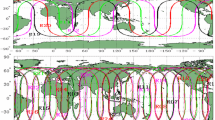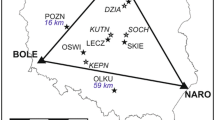Abstract
With GLONASS completed its full constellation and the rapid increasing number of GNSS receivers, it is worthwhile to investigate the availability of GLONASS-only in positioning. In this paper, two networks of different baseline length, located in two different regions are analyzed. For both networks, GLONASS and GPS observations are processed respectively for 175 days since GLONASS recovered FOC. The RMS and STD of the coordinates minus those from the International GNSS Service weekly solutions are analyzed. The statistics over a long period empirically demonstrate that the averaged coordinate repeatabilities of GLONASS are slightly worse than that of GPS results. The estimated ZTDs of GLONASS is about 1–2 mm worse than GPS results. For both networks, the GLONASS coordinates show some systematic effect as a function of antenna + radome type, caused by the using of GPS derived PCC models. The systematic effect varied form several mm to 1 cm for different stations with different antenna + radome types, which indicates that GLONASS-specific PCC models are mandatory in GLONASS high precision positioning.

















Similar content being viewed by others
References
Alcay S (2012) Contribution of GLONASS Observations on Precise Point Positioning FIG Working Week 2012, Knowing to manage the territory, protect the environment, evaluate the cultural heritage Rome, Italy, 6–10 May
Alcay S, Inal C, Yigit CO, Yetkin M (2012) Comparing GLONASS-only with GPS-only and hybride positioning in various length of baselines. Acta Geod Geophys Hung 47(1):1–12
Bruyninx C (2007) Comparing GPS-only with GPS + GLONASS positioning in a regional permanent GNSS network. GPS Solutions 11:97–106
Cai C, Gao Y (2007) Precise point positioning using combined GPS and GLONASS observations. J Glob Positioning Syst 6(1):13–22
Dach R, Hugentobler U, Fridez P, Meindl M (2007) Bernese GPS software version 5.0, Astronomical Institute, University of Bern
Dach R, Brockmann E, Schaer S, Beutler G, Meindl M, Prange L, Bock H, Jäggi A, Ostini L (2009) GNSS processing at CODE: status report. J Geod 83:353–365
Dach R, Schmid R, Schmitz M, Thaller D, Schaer S, Lutz S, Steigenberger P, Wübbena G, Beutler G (2011) Improved antenna phase center models for GLONASS. GPS Solution 15:49–65
Gibbons G (2009) What Race? What Competition. GNSS WORLD. March/April. 16–17
Mirgorodskaya T, Revnivykh S (2011) GLONASS Status and Plans. 2nd China Conference on Satellite Navigation, Shanghai, People’s Republic of China, 18–20 May
Oleynik E (2011) GLONASS Status and Modernization. United Nations/Latvia Workshop on the Applications of Global Navigation Satellite Systems. 14–18, May
Oleynik E, Revnivykh S (2011) GLONASS Status and Modernization. Civil GPS Service Interface Committee, Portland, Oregon, 19 September
Revnivykh S (2007) GLONASS Status, Development and Application. International Committee on Global Navigation Satellite Systems (ICG) Second Meeting, Bangalore, India, 4–7 September
Russian Federation (2007) Status of the glonass system and its use within GNSS. International Civil Aviation Organization WORKING PAPER
Stewart MP, Tsakiri M, Wang J, Monico JF (1999) The contribution of GLONASS measurements to regional and continental scale geodetic monitoring regimes. International Symposium on GPS - Applications to Earth Sciences and Interaction with Other Space Geodetic Techniques (GPS99) , Tsukuba, Japan, 19–22 Oct
Wang J, Wang J (2007) Comparing Long Baseline Results from GPS and GPS/GLONASS. Combined Int. Symp. and Exhibition on Geoinformation and NGSS, Johor bahru, Malaysia, paper 59
Zinoviev AE (2005) Using GLONASS in Combined GNSS Receivers: Current Status. Proceedings of ION GNSS 2005, Long Beach, CA, 13–16 September
Acknowledgments
This study was supported by National Natural Science Foundation of China (No: 41074023 and 41004014).
Author information
Authors and Affiliations
Corresponding author
Rights and permissions
About this article
Cite this article
Zheng, Y., Nie, G., Fang, R. et al. Investigation of GLONASS performance in differential positioning. Earth Sci Inform 5, 189–199 (2012). https://doi.org/10.1007/s12145-012-0108-9
Received:
Accepted:
Published:
Issue Date:
DOI: https://doi.org/10.1007/s12145-012-0108-9




